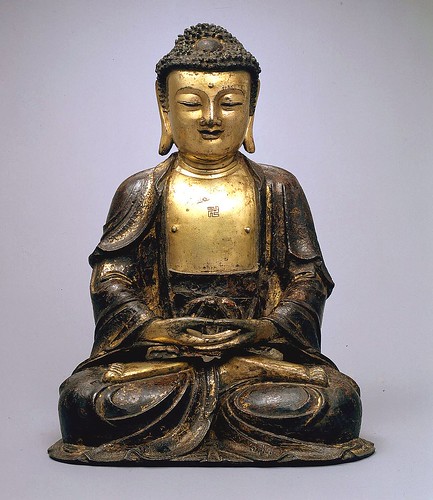The Four Noble Truths
1. Life is suffering;
2. Suffering is due to attachment;
3. Attachment can be overcome;
4. There is a path for accomplishing this.
1. Suffering is perhaps the most common translation for the Sanskrit word duhkha, which can also be translated as imperfect, stressful, or filled with anguish.
Contributing to the anguish is anitya -- the fact that all things are impermanent, including living things like ourselves.
Furthermore, there is the concept of anatman -- literally, "no soul". Anatman means that all things are interconnected and interdependent, so that no thing -- including ourselves -- has a separate existence.
2. Attachment is a common translation for the word trishna, which literally means thirst and is also translated as desire, clinging, greed, craving, or lust. Because we and the world are imperfect, impermanent, and not separate, we are forever "clinging" to things, each other, and ourselves, in a mistaken effort at permanence.
Besides trishna, there is dvesha, which means avoidance or hatred. Hatred is its own kind of clinging.
And finally there is avidya, ignorance or the refusal to see. Not fully understanding the impermanence of things is what leads us to cling in the first place.
3. Perhaps the most misunderstood term in Buddhism is the one which refers to the overcoming of attachment: nirvana. It literally means "blowing out," but is often thought to refer to either a Buddhist heaven or complete nothingness. Actually, it refers to the letting go of clinging, hatred, and ignorance, and the full acceptance of imperfection, impermanence, and interconnectedness.
4. And then there is the path, called dharma. Buddha called it the middle way, which is understood as meaning the middle way between such competing philosophies as materialism and idealism, or hedonism and asceticism. This path, this middle way, is elaborated as the eightfold path.
The Eightfold Path
1. Right view is the true understanding of the four noble truths.
2. Right aspiration is the true desire to free oneself from attachment, ignorance, and hatefulness.
These two are referred to as prajña, or wisdom.
3. Right speech involves abstaining from lying, gossiping, or hurtful talk.
4. Right action involves abstaining from hurtful behaviors, such as killing, stealing, and careless sex.
5. Right livelihood means making your living in such a way as to avoid dishonesty and hurting others, including animals.
These three are referred to as shila, or morality.
6. Right effort is a matter of exerting oneself in regards to the content of one's mind: Bad qualities should be abandoned and prevented from arising again; Good qualities should be enacted and nurtured.
7. Right mindfulness is the focusing of one's attention on one's body, feelings, thoughts, and consciousness in such a way as to overcome craving, hatred, and ignorance.
8. Right concentration is meditating in such a way as to progressively realize a true understanding of imperfection, impermanence, and non-separateness.
The last three are known as samadhi, or meditation.
Source: http://webspace.ship.edu/cgboer/buddhawise.html
skip to main |
skip to sidebar
For students and parents who love education and exploration of the social sciences . . .
Search This Blog
Followers
Blog Archive
-
▼
2011
(242)
-
▼
May
(27)
- Ni hau! Sayonara! Salaam! Shalom! Namaste! Ciao! A...
- Tokyo to Totoro quiz
- Caddo peoples established trade road that connecte...
- Semester exam: 100 questions from the online quizz...
- Known colloquially as Oz, the name Australia means...
- A small quiz on the 50th state, Hawaii
- The in-class Japanese garden project
- Pearl Harbor: Honolulu, Oahu, Hawaii
- Adding Australia to the map of East Asia
- Transformations: the British-Japanese movie Howl's...
- Japan WWII: a military-dominated society
- Magnet geography: Japan
- Nippon review questions
- Howl's Moving Castle and Cosplay
- Bento: Japanese lunch in a beautiful box
- The Godfather of Anime, the late Japanese artist O...
- Miyazaki Hayao Miyazaki and the Japanese sense of ...
- Pictorial report on Japan
- Semester exam: 100 multiple choice questions pulle...
- Basic Japanese phrases
- From the Red Sea to the mountains of the Hindu Kus...
- Saddam Hussein and Osama bin Laden; which is which?
- Osama bin Laden's beliefs
- Buddhism and spiritual rebirth
- Karma in the Buddhist way
- Buddhism and Siddhartha Gautama
- The 4 Noble Truths: basics of the path called Budd...
-
▼
May
(27)

